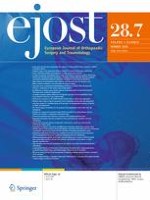Published in:

01-10-2018 | Original Article • HIP - PAEDIATRICS
A simple, precocious, and reliable way to assess future clinical outcome in children with Perthes disease and mild femoral head involvement: correlation between MRI with diffusion-weighted and dynamic gadolinium-enhanced subtraction and Catterall and Herring classifications
Authors:
Vincenzo De Rosa, Meryle Laurent, Federico Canavese, Laura Merlini
Published in:
European Journal of Orthopaedic Surgery & Traumatology
|
Issue 7/2018
Login to get access
Abstract
Background
In children older than 5 years with a mild form of Legg–Calvé–Perthes disease, the outcome is difficult to predict. In this study, we retrospectively correlated gadolinium-enhanced subtracted (DGS) and diffusion (DWI) MRI findings to the radiographic assessment according to the Catterall and Herring et al. classifications and to the final score according to Stulberg et al.: the aim was to identify a precocious, simple, and objective criterion to differentiate between forms evolving favourably and forms requiring an early surgical treatment in order to avoid femoral head deformity and subsequent osteoarthritis.
Methods
Twelve boys with unilateral mild femoral head involvement (Catterall grade 2 or grade 3) underwent DSG and DWI MR during the early phase of the disease. The absence of enhancement of the external pillar on DSG MRI and the presence of metaphyseal hyperintensity on DWI were considered to be the signs of poor outcome. These findings were correlated with the Catterall and Herring et al. classifications at the initial sclerotic stage and early fragmentation phase and with the Stulberg et al. classifications at least 5 years after the onset of the disease.
Results
DSG MRI findings correctly discriminated three out of four patients with a good outcome but underestimated two out of eight patients with a poor outcome. DWI findings correlated with the Catterall and Herring et al. classifications in 12 out of 12 cases. In only one case, DWI findings did not correlate with the Stulberg et al. classification.
Conclusion
DWI MR provides an objective and accurate prognostic criterion that is relatively easy to recognise. DGS MR findings are less accurate, thus underestimating the gravity of the disease in one-fourth of the patients with a poor outcome.





